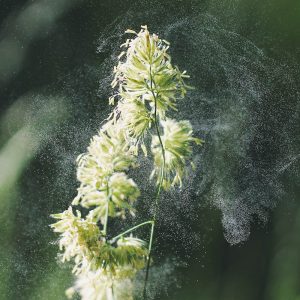Achoo! It’s pollen season. You might sneeze, and you might have to wash your vehicle to remove the green, dust-like coating that comes from plants.
We asked Lynn Barber, the Florida-Friendly Landscaping™ agent at UF/IFAS Extension Hillsborough County and Alyssa Vinson, the horticulture agent for UF/IFAS Extension Manatee County to tell us the most common questions they get asked about pollen season, along with their answers.

Q: Why does there seem to be so much pollen this year?
A: Looking at various weather forecasts, pollen is expected to be higher than normal this year. Pollen rates fluctuate in response to environmental triggers such as temperature and humidity. In warmer years, trees will produce more pollen. Of the three major trees producing much pollen this year, oak, pine and palm are the major culprits. The amount of pollen they produce increases with wind and warm weather.
Q: How many people are impacted by pollen, and what are common symptoms of allergic reactions to it?
A: Nationally, about 50 million people are affected by allergies each year.
They could experience a wide variety of symptoms, including watery eyes, itching, coughing, congestion, hives, runny nose, fatigue, asthma attacks and, in severe cases, death.
Q: Do all flowering plants, including trees, produce pollen?
A: Yes, and that is so they can reproduce. Plants pollinated by insects don’t have to produce as much pollen because insects distribute pollen efficiently. But plants that do not rely on pollinators produce more pollen, and wind carries pollen seemingly everywhere, including onto your car.
Q: How far can pollen travel?
A: Because pollen is light and dry, it can float through the wind and travel up to several miles.
Q: How can you reduce your chances of exposing yourself to pollen?
A: Dry clothes in a dryer, rather than hanging them outside. This way, you avoid pollen collecting on clothing and being carried indoors. Considering limiting outdoor activities during pollen season (January to June). Stay inside during peak pollen times (10 a.m. to 4 p.m.). Shower after spending time outdoors to remove pollen from hair and skin.
Q: What is the source of pollen in oak trees?
A: Oak trees contain both male and female flowers. Unlike other plants that may have male and female parts in one flower (perfect flowers), oak trees have both male flowers and female flowers. The male flower is where the pollen is produced.
Q: Why do pollen and leaves fall at the same time?
A: Certain trees hold onto their leaves throughout the winter and shed them in the spring to make room on their branches for reproduction and the growth of new foliage for the spring and summer seasons.
Click here to find out more about how to cope with pollen.
###
Para accesar a esta comunicación en español, por favor utilice este enlace.
ABOUT UF/IFAS
The mission of the University of Florida Institute of Food and Agricultural Sciences (UF/IFAS) is to develop knowledge relevant to agricultural, human and natural resources and to make that knowledge available to sustain and enhance the quality of human life. With more than a dozen research facilities, 67 county Extension offices, and award-winning students and faculty in the UF College of Agricultural and Life Sciences, UF/IFAS brings science-based solutions to the state’s agricultural and natural resources industries, and all Florida residents.
ifas.ufl.edu | @UF_IFAS
 2
2
